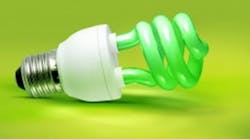First, Swedish pulp producer Södra Cell transformed its Värö pulp mill over the past 10 years from a large-scale energy consumer to a fossil-free electricity generator by burning waste bark, branches and wood chips and retaining flue gases from its wastewater system's recovery boiler. In fact, the mill not only produces enough power to make 425,000 tons of chlorine-free pulp per year, but it also produces 550 gigawatt hours (GWh) of surplus electricity that's either sold back to the national grid, helps heat the local town of Varberg or sold as biofuel to other power plants or industrial users. At the heart of Södra Cell's operations is ABB's 800xA Extended Automation System, which controls, optimizes and integrates every component in the mill's pulp and energy production processes. "All of these control systems are connected in a common interface, which enables us to control what's happening in the various parts of our operations," says Ola Walin, Södra Cell Värö's maintenance manager. Over the past few years, Södra Cell also has invested about $300 million to reduce the mill's energy consumption, including building a new evaporation plant to improve energy efficiency and adding feed-water preheating to increase electricity production, flue-gas cooling to increase output of district heating, and bark drying to optimize fuel quality for district heating."
Second, China's oldest cement company, Huaxin Cement, reports its Zigui plant in Hubei province is saving 1.6 million kilowatt hours (kWh) per year and corresponding greenhouse gas emissions at its new, 2-kilometer, downhill conveyor, which moves crushed limestone from a nearby mine and down a 320-meter elevation to its storage yard. Downhill conveyors are demanding applications that need continuous braking to prevent excessive movement of the belt as it moves downhill. The Zigui plant's conveyor belt is driven by two 500-kW motors that are controlled by an ABB ACS800 multidrive with a regenerative supply unit that feeds power back into the grid. The drive provides dynamic control of the speed and torque of the motors, and enables soft starting and stopping of the conveyor belt. Soft starting eliminates mechanical stress during start-up and prevents the material from spilling and the belt from folding. During downhill operation, the drive harnesses the energy produced by the conveyor system and feeds it back into the cement plant's power network.
Third, to recover more copper and precious metals from electronic scrap at 10% to 15% of the cost of extraction from ore, Boliden is building a second electronics recycling facility next to its existing recycling plant at the Rönnskär copper smelter and integrated metallurgical complex in northern Sweden. This expansion will almost triple the site's recycling capacity from 45,000 metric tons to 120,000 metric tons per year, making it the world's largest e-scrap recycling facility, and will enable Rönnskär to be less dependent on copper concentrates and more energy efficient. Boliden already uses its proprietary Kaldo furnace technology at the existing plant, which smelts pre-sorted, pre-shredded e-scrap, and then transfers molten metals to adjoining production lines for processing into high-grade products. For the new Kaldo plant, scheduled to reach full capacity in 2012's second quarter, ABB supplied automation and power technologies, including its process control system. In fact, the entire e-scrap recycling process is controlled by ABB's 800xA, and includes customized features such as remote operation of the process and an exact positioning system to prevent spilling of molten metal from the furnace.
The System 800xA solution for the Kaldo plant expansion is integrated with Rönnskär's existing System 800xA distributed control system, which controls the entire site and all its production processes. On the new plant's electrical side, ABB's solutions include low- and medium-voltage switchgear to ensure safe and reliable power distribution and low-voltage drives to control motor speeds and further reduce energy consumption.






